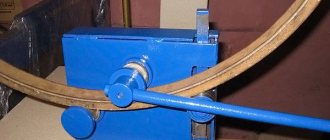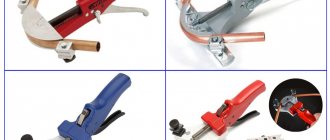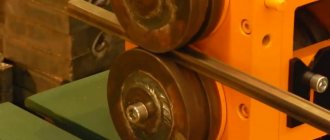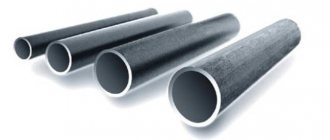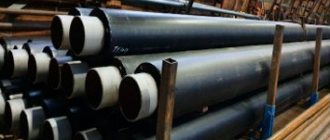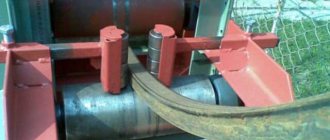Rolled metal in the form of profile pipes is widely used in private housing construction. It often has to be bent when making various structures. To do this, professionals use a pipe bender for profile pipes of various sections. Let's look at the special device in more detail and find out its application, classification, design features, existing varieties, and their advantages.
Device for bending a pipe profile Source hobbywork.ru
Definition and Application of Pipe Bender
Profile pipe – rolled metal in the form of a hollow pipe product with any cross-section. The only exception is round steel. The most popular pipes are those with rectangular and square cross-sections. Such rolled metal can withstand significant loads due to the presence of hard corners.
Construction is one of the areas where profile pipes are widely used. It is used during the construction of small architectural forms and large objects. In this case, not only products with rectilinear geometry are used. During the work, specialists have to bend straight pipes with a profile section at different angles at a construction site or in a factory, or even twist it into a spiral. Professionals do not use handicraft devices for such operations. They use a special mechanism - a profile pipe bender. It is also called a profile bender. It simplifies the process and allows, with minimal time, to achieve the desired shape of initially straight rolled metal.
Roll forming device Source prostanki.com
Bending a tubular product with a cross-section of a rectangular, square or other shape other than a circle is an alternative to cutting solid metal products into separate fragments, from which a single structure of the desired configuration is subsequently made by welding. The use of a profile bender allows you to immediately create curved blanks from corrugated pipes without violating their original integrity.
Manufacturers produce a wide range of roll forming equipment for pipes made of various materials, with almost any cross-section, diameter and wall thickness. It is used to create:
- small greenhouses and entire complexes;
- elements for stairs;
- free-standing sheds and those attached to the house;
- gazebos;
- frame buildings with arched elements;
- fences and barriers with curved parts;
- street furniture;
- designs for house benches, sports and children's playgrounds.
Arched element of a greenhouse made from corrugated pipe Source ad-cd.net
To bend the required profile, specialists use appropriate attachments in each specific case. They are usually included with pipe bending equipment. Devices can also be equipped with them.
The structure of a pipe bending machine and instructions for its assembly
Regardless of what consumables and mechanisms you have in your home workshop or garage, a do-it-yourself profile pipe bending machine can be made according to various design schemes. Having made even the simplest homemade pipe bender, in the future, if the need arises, you can improve its design by providing such equipment with a number of additional functions.
Design of a pipe bending machine (sectional view)
The main design elements of any machine used to bend pipes are:
- supporting frame, which is made of a powerful metal profile;
- three shafts rotating on separate axes (it is through such elements, which must be highly durable, that bending machines act on the profile pipe, deforming it to the required bending angle);
- a mechanism by which the working shafts are driven into rotation;
- chain connecting the elements of the drive mechanism.
Before making homemade bending equipment, it is advisable to prepare a drawing of it or find a ready-made one on the Internet. Moreover, there you can also find a video with detailed instructions explaining the process of manufacturing a device for bending profile pipes.
Pipe bender drawing
Once the drawing of the pipe bender has been prepared, you can begin assembling the supporting frame. If you plan to use your pipe bending machine for large-diameter pipes, then it is better not to use welding to assemble its supporting frame: it will not be able to provide the equipment structure with the required reliability. In such cases, it is better to connect the frame elements together using bolts. The use of bolted connections will also make your pipe bending machine more mobile; you can quickly disassemble it and transport it to another location at any time.
Pipe bender parts: bearings, shafts and chain drive
The shafts that are equipped with any bending machine for a profile pipe are cylinders with axes of rotation, made of high-strength steel. As mentioned above, three working shafts are installed on a pipe bending machine, with two of them fixed slightly above the surface of the work table, and the third above them. Pipe bending radii depend on the distance at which the working surfaces of the lower shafts are located between each other. Thus, if, when creating your pipe bending machine, you immediately provide in its design the possibility of horizontal movement of the lower shafts and vertical movement of the upper one, you will be able to adjust the parameters of the bend being performed, as well as process pipes of various sizes.
U-shaped carriage welded from thick metal with a pressure shaft
To secure the bearings, “crescents” made of 4 mm metal are used
After all the working shafts of the pipe bending machine are installed on the frame, it is necessary to assemble a mechanism that will cause them to rotate. As such a mechanism, it is best to use a chain drive, the elements of which will be three sprockets and the chain itself, corresponding to them in its parameters. Two sprockets are installed on both lower shafts of the pipe bender for a profile pipe, and the third is fixed below, on one of the elements of the supporting frame. It is very important to be able to change the position of the lower sprocket, as this will allow you to tension the chain on the pipe bender. So that the drive mechanism of the machine can be easily controlled, a handle is fixed on one of the sprockets, which should be made not only durable, but also as convenient to use as possible.
The pipe bender is assembled and ready for testing
Upon completion of assembly of the machine, a test bend of the pipe should be performed on it. If you are satisfied with the test results, you can start using your equipment.
Classification of bending equipment
A modern profile pipe bender can have different designs. Professional craftsmen engaged in the manufacture of products and structures from profiled assortments can use the following devices in their work:
- portable and stationary equipment;
- devices with different types of drive (electric, manual, hydraulic devices);
- machines that differ from each other in the way they influence the workpiece.
The assortment, which has undergone profiling during the manufacturing process, can be bent by rolling, winding or rolling. The latter method is also called rolling.
Run-in
This method of influence involves clamping one end of the pipe. The required bend is given to it using a stationary template. The tubular product is rolled around a stationary part using pressure rollers.
Rectangular bar rolling machine Source wp.com
Winding
In pipe bending equipment that operates on the winding principle, the workpiece is pressed against a template roller. During the bending process, the pipe is wound around a moving part. The tubular product is pulled between a template that performs rotational movements and a special thrust element that acts on the workpiece at the starting point of bending.
See also: Catalog of companies that specialize in the design and installation of metal structures
Rolling
A bend of the required radius is created when using a device whose design contains three shafts. Of these, two are support rollers. The third element is the central shaft. The bending radius of the profile depends on its spatial position. The rolling bending device is a more versatile equipment than devices operating on the principle of winding and rolling. After all, the bending radius of the workpiece directly depends on the installed template.
Rolling pipe bending device in a compact housing Source kovkapro.com
Experts select a factory pipe bender for professional pipes depending on the required bending radius of the workpiece. At the same time, they must take into account the cross-section and wall thickness of the tubular product.
Types of machines for bending profile pipes
There are many equipment modifications for changing the configuration of profile pipes. This is due to the minimum bending radius. If we neglect this important parameter, the strength characteristics of the material will change for the worse at the bending point. You also need to know some of the technological subtleties of bending metal pipes and take them into account during work.
When choosing a design, take into account the workpiece material, diameter, and wall thickness.
Classification of bending machines by drive type
Depending on the type of drive, machines designed for bending any pipes are manual, electromechanical and hydraulic.
Manual. These are extremely simple mechanisms that can be manufactured independently even by a person not versed in the intricacies of working with metal.
A manual, self-made machine for bending profile pipes is an indispensable assistant in the manufacture of frames, decorative elements, and self-installation of a ventilation system.
Electromechanical. Such a machine has a drive in the form of an electric motor - stepper or conventional, connected through a lower gearbox. The latter solution ensures high-quality bending due to correct stress distribution.
The structure of the mechanism is not simple; in order to make it, you need special knowledge and at least a little professionalism.
Electrically driven roll forming machines in most cases have the form of a 3-shaft design. A profile pipe is passed between the rollers. An element located in the center can change its vertical coordinates. When the central shaft rotates, the profiled pipe changes its geometry
Hydraulic. The drive in this model is manual. Unlike the simple manual design, here a hydraulic cylinder is included in the design, which significantly reduces the muscular effort applied during bending.
Rollers make it possible to bend a profile pipe in any desired direction. A manual profile bender with hydraulics, with its light weight, can bend pipe assortments up to 10 cm wide.
The hydraulic cylinder of a roll forming machine exerts pressure on the surface of the pipe through mechanical action. This causes the cylinder rod to move. As a result of the resulting load, the product is deformed. The pressure in the piston can be increased in two ways - manually and using an electric pump
Types of pipe benders by installation method
There is a division of profile benders depending on the installation method. There are stationary, portable and wearable equipment. Stationary machines can take the form of a simple concrete slab with rods or solid equipment.
Compact portable pipe benders have a support stand, but the portable model does not have a support; it is selected each time the equipment is used.
Classification of machines by bending method
The design of the profile bender and its performance will depend on the bending method. There are 3 main bending methods. The first is extrusion, when the geometry of the profile pipe is changed using a deforming roller that acts as a punch. In this case there is no matrix.
To perform the operation, 2 strong supports are required on opposite sides of the bend, which act as a matrix. Rotary shoes or rollers are used as such supports.
Since the force increases gradually and is constantly perpendicular to the pipe, the method makes it possible to obtain a good final result. We apply the method only for small-scale work.
The second is pressing. To obtain a bend, the principle of a bench vice is used - a piece of pipe is placed between the matrix and the punch.
To obtain a high-quality bend, the profiles of the latter must exactly repeat the geometry of the part. And also in the calculation it is necessary to take into account the residual deformation of the metal. At home, this method is applicable when great accuracy is not required.
The machine for changing the shape of a profile pipe by rolling consists of three cylindrical rollers, a chain, a drive and a base. The diameter of the rollers must correspond to the parameters of the deformable profile pipe
The third is rolling - a universal method used for bending both thin- and thick-walled pipes. The bend is produced by pulling the workpiece between rollers - one rotating and two supporting.
In addition to those mentioned above, pipe bending can also be carried out using the following methods:
Image gallery
Photo from
Rolling pipe bending method
Crossbow method of bending pipes
Pipe bending by rolling method
Pipe bending using the winding method
Regardless of the chosen design, when independently manufacturing a pipe bending machine, it is necessary to take into account the recommendations of specialists. When choosing a material for the frame, you need to proceed from the fact that the thickness of the metal should be at least 1/6 of the width of the profiled pipe.
So, if you have to bend a pipe with a rectangle in cross-section with parameters of 50 x 25 mm, then in order to avoid deformation of the frame during the bending process, you need to take a channel or angle with a thickness of at least 10 mm. The base plate and punch with the matrix must be 2 times thicker.
The optimal diameter of the rollers is at least triple the cross-sectional dimensions. The shelf of the channel and angle taken to make the frame should be 2 and 3 times the width of the pipe, respectively. If you have to bend profile pipes with a rectangular section of 50 x 25 mm, you need a 100 x 10 channel or a 150 x 10 angle.
Manual profile benders
Devices for bending hollow metal of any cross-section, which operate solely using muscular force, are manual pipe benders. These are mobile devices. They are small in size and weight.
Professionals use this type of roll forming devices to produce the required products at the installation site. One of the most common machines is a profile bender with three template rollers. It is around them that the workpiece moves when bending work is performed directly at the customer’s site. Using a manual profile bender, a craftsman can produce the required parts at any time. The machine also allows you to adjust their curvature at the installation site.
After inserting a straight profile pipe into the device, a product bent at the desired angle comes out of a manual pipe bending device. In this case, the bend can be whatever you want.
Manual roll benders Source equipnet.ru
Specialists use a manual pipe bender for square pipes and hollow rectangular products, as well as for bending strips, squares, round pipes, rods, and angles. The device has a simple design. It contains no electronic components. To use it, you do not need to perform complex preliminary settings. In this case, the workpiece is bent with high precision in accordance with a predetermined radius.
Other advantages of the roll forming machine include:
- high degree of safety during the processes performed;
- no need to connect to the electrical network;
- easy transportation;
- large area of application.
A manual roll forming machine is a reliable device. It is made from high quality steel, including alloy grades. This manufacturing material provides high strength to the mechanism.
Roller shafts for pipe benders are made in different sizes. Their design allows you to carefully bend corrugated pipes. In this case, it does not require much effort, regardless of the material of the workpiece, which can be steel, aluminum and copper.
Pipe bending roller shafts Source ufaprom.ru
How to make a profile bender of an even simpler design
You can make a roll forming machine with your own hands using an even simpler design. If you choose a device of this type, you should keep in mind that in order to bend a profile pipe with your own hands on such a device, you will need serious physical effort.
Drawing of a small manual profile bender mounted on a mechanic's workbench (click to enlarge)
If bending equipment equipped with working shafts is used for rolling a profile pipe, during which it is bent, then the profile benders of the simplest design in question work on a different principle. On devices of this type, a profile pipe is bent along a radius, which must first be formed from rigidly fixed elements. Strong metal pins fixed in a concrete base are most often used as such elements. An arc is formed from such pins, along which the corrugated pipe is bent.
To make a device on which it will be possible to effectively bend a pipe along a radius, it is best to pour a concrete pad yourself and fix the metal pins on it as securely as possible.
Bending steel pipes, for which such a simple device is used, is carried out in the following sequence.
- One end of the pipe is securely fixed.
- By physically influencing the second, loose end of the pipe, they begin to bend the product smoothly and accurately, bending its surface around the pins arranged in an arc.
- After the pipe has acquired the required configuration, its second end is also fixed and the product is left in this position for some time so that the metal gets used to the new state.
Since working with such a device requires significant physical effort, to make the task easier (especially when bending large-diameter pipes), the future bend site is preheated with a gas burner or over a fire. You can learn more about the rules of operation on such a device in the corresponding video.
Of course, such a device, which can be built in the yard of your home, has minimal efficiency and functionality. For example, it is quite difficult to bend stainless pipes or make complex bends with it. Nevertheless, it is quite possible to use it for simple bending work. Such work, for example, may be associated with laying a pipeline or making a frame for a home greenhouse.
Hydraulic roll forming machines
Hydraulic roll bending mechanisms allow efficient bending of pipe assortments with complex profiles. When using such equipment, the specialist makes minimal physical effort, because the main actions are performed by the hydraulic system.
A bending device with hydraulics for corrugated pipes is a more advanced mechanism than a manual profile bender. The equipment is equipped with wolves for horizontal and vertical rolling of workpieces. This allows you to bend the rolled product in several directions at various required angles and required radii in one operation.
A standard machine with hydraulics for bending profile pipes is equipped with 3 rollers. One of them is pressure rollers, and the other two are drive rollers. For their manufacture, manufacturers use durable alloy steel. For this reason, rollers rarely have to be replaced with new rollers. If necessary, they can be easily removed from the hydraulic machine, which allows for quick service work.
We make a hydraulic pipe bender
Let's consider the diagram of a machine with a hydraulic drive, where bending occurs due to pressing a profile pipe in the center with a punch fixed on a rising rod. As a result of close contact of the workpiece, supported by two stationary rollers, with the movable punch, the latter takes on its outline.
This type of machine is called a crossbow machine due to the similarity of the outline of the punch with the shape of a crossbow. Its main parts are the base (1), hydraulic jack (2), punch (3) and fasteners in the form of bolts. The layout of machine components is carried out according to the sketch
To mark the working surface, lay a vertical axis and, at the distance indicated in the drawing from the edge and axis, mark the location of the lower holes. Then mark the location of the upper holes, retreating the required distance from the edge. Connect the center of these holes with a straight line and lay equal segments on it.
The axes of the intermediate holes will be located at the intersection of the marks made with the inclined axis. Holes on the working surface are needed to be able to adjust the bending radius of the profile workpiece. Since the working surface consists of two mirror-like parts, the second one is marked in the same way.
The height of the machine is determined by the parameters of the jack and the distance indicated in the drawing by the symbol “a”. To bend a profile pipe 15 mm wide, this gap when the jack is not in use should be approximately 20 mm.
In this design, the force transmitted by the punch is concentrated in its upper part. As a result of this effect, the outer radius of the pipe is subject to tension, which can cause thinning of the wall, and in some cases, rupture. Therefore, this machine is not recommended for deforming thin-walled workpieces.
Video description
See the video for operating features of a hydraulic pipe bender.
Hydraulic profile benders are also equipped with three grooves, but they allow you to work with pipes of a larger cross-section. Its maximum dimensions can be 60*30 mm. Moreover, most models are capable of bending square pipes with a maximum cross-sectional size of 40*40 mm. A hydraulic machine for bending profiled pipes also allows you to bend rods, strips and round pipes.
The presence of an engine braking device increases the ease of use of pipe bending equipment with hydraulics. It allows you to stop the machine if adjustments need to be made. After this, the process can be continued further using the same workpiece. In addition, machines of this type are variable units. In other words, the devices can be manual, semi-automatic and fully automatic devices for bending corrugated steel pipes.
Making a lever pipe bender
A selection of photographs and drawings for making a lever-type pipe bender yourself, as well as a video with comments and explanations from the author.
This lever pipe bender is not too difficult to manufacture and allows you to work with fairly thick pipes
A video from the author will allow you to understand the key points and small nuances of manufacturing this pipe bender.
Electric profile benders
Manufacturers also equip equipment for bending corrugated pipes with an electric drive. This machine for a profile pipe is a professional device that allows you to bend the workpiece as accurately as possible in accordance with the given dimensions. Electric profile bending machines are used by specialized companies for the serial production of bent parts of metal structures. Its customizable rollers are designed for bending metal products, which can be made from various steel, copper, aluminum alloys and so on.
High-quality steel is used in the manufacture of electric pipe benders. Rolling rollers are made from it. They are highly wear resistant. Therefore, they do not have to be replaced frequently with new parts.
Electric pipe benders for corrugated pipes are not mobile devices. They are stationary equipment. For their operation, a constant connection to the electrical network is required. Such machines are installed in production shops and forging plants.
Video description
The operation of an electric stationary profile bender is shown in the following video:
One of the main advantages of electric profile benders is the minimum physical effort of the master, even when performing a large amount of work. The only exception may be the installation of workpieces and the acceptance of curved parts.
Electrically driven pipe benders make it possible to produce bent metal products of high quality. Manufacturers produce models in which the bending angle is adjusted manually or using special programs. The second version of the equipment is equipped with a remote or built-in display. It is designed to monitor ongoing operations on an electric profile bending machine.
Video description
The following video will help you get acquainted with the operation of a stationary profile bender with a remote display:
The maximum and minimum dimensions of a pipe bender with an electric drive depend on the capabilities of the equipment, whether it is equipped with additional functions, and the number of rollers. The performance of the electric profile bender is affected by the power of the installed motor. This characteristic can be 0.7-2.2 kW. The power of the electric motor is selected depending on the production tasks. A set of attachments is usually supplied with the equipment. They allow you to work with different profiles. Their number can always be increased.
The most powerful and productive profile bending machine is CNC equipment. This is already an industrial machine that allows you to work with a wide variety of metal profiles. With its help, three-dimensional bending of rolled products is carried out. Blanks can be made from different metals, including aluminum, stainless steel, copper, bronze.
CNC machine equipment for bending corrugated pipes is controlled mainly by a servo drive. This is the most popular option, the effectiveness of which has been tested in practice.
Stationary CNC pipe bending machine Source jcee.cz
Briefly about the main thing
A modern bending machine for profiled pipes is a compact, portable or stationary equipment that allows you to bend rolled metal pipes with square, rectangular and other cross-sections. It is used by large and small manufacturing enterprises that produce metal structures from corrugated pipes. Manufacturers produce equipment with manual, hydraulic and electric drive. Profile benders are also classified according to the method of influencing the metal workpiece. Pipe benders can carry out rolling, winding or rolling of profiled metal products.

